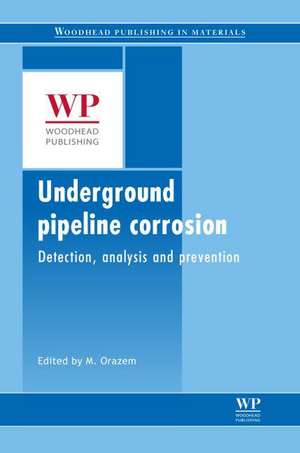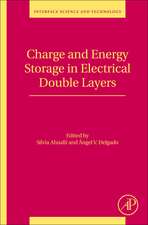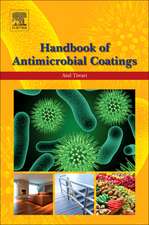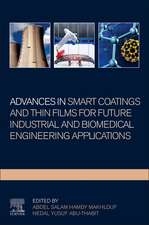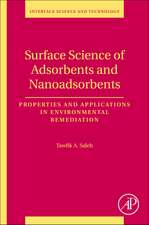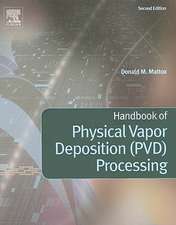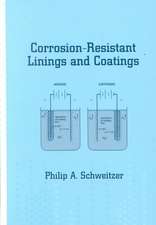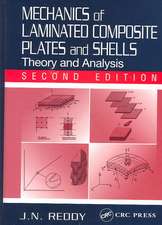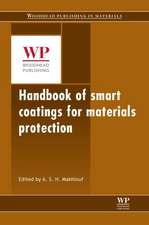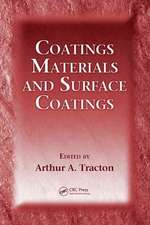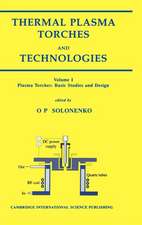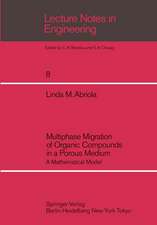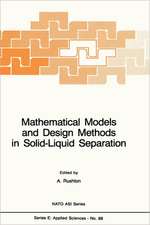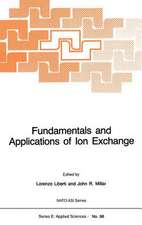Underground Pipeline Corrosion
Editat de Mark Orazemen Limba Engleză Hardback – 21 ian 2014
The topics covered in part one include: basic principles for corrosion in underground pipelines, AC-induced corrosion of underground pipelines, significance of corrosion in onshore oil and gas pipelines, numerical simulations for cathodic protection of pipelines, and use of corrosion inhibitors in managing corrosion in underground pipelines. The methods described in part two for detecting corrosion in underground pipelines include: magnetic flux leakage, close interval potential surveys (CIS/CIPS), Pearson surveys, in-line inspection, and use of both electrochemical and optical probes. While the emphasis is on pipelines transporting fossil fuels, the concepts apply as well to metallic pipes for delivery of water and other liquids.
Underground Pipeline Corrosion is a comprehensive resource for corrosion, materials, chemical, petroleum, and civil engineers constructing or managing both onshore and offshore pipeline assets; professionals in steel and coating companies; and academic researchers and professors with an interest in corrosion and pipeline engineering.
- Reviews the causes and considers the detection and prevention of corrosion to underground pipes
- Addresses a lack of current, readily available information on the subject
- Case studies demonstrate how corrosion is managed in the underground pipeline industry
Preț: 867.84 lei
Preț vechi: 1264.28 lei
-31% Nou
Puncte Express: 1302
Preț estimativ în valută:
166.10€ • 172.76$ • 139.20£
166.10€ • 172.76$ • 139.20£
Carte tipărită la comandă
Livrare economică 06-20 martie
Preluare comenzi: 021 569.72.76
Specificații
ISBN-13: 9780857095091
ISBN-10: 0857095099
Pagini: 340
Ilustrații: illustrations (black and white)
Dimensiuni: 156 x 234 x 27 mm
Greutate: 0.65 kg
Editura: ELSEVIER SCIENCE
ISBN-10: 0857095099
Pagini: 340
Ilustrații: illustrations (black and white)
Dimensiuni: 156 x 234 x 27 mm
Greutate: 0.65 kg
Editura: ELSEVIER SCIENCE
Cuprins
Contributor contact details
Woodhead Publishing Series in Metals and Surface Engineering
Introduction
References
Versatile
Part I: Understanding and managing corrosion processes
1. Understanding corrosion in underground pipelines: basic principles
Abstract:
1.1 Introduction
1.2 Electrochemical corrosion: conventional current theory
1.3 Electrochemical corrosion: advanced theories
1.4 Other factors in corrosion
1.5 Reference cells
1.6 Corrosion processes affecting pipelines
1.7 Environmental cracking
1.8 Microbiologically influenced corrosion
1.9 Corrosion protection methods: coatings
1.10 Corrosion protection methods: cathodic protection (CP)
1.11 Conclusion
1.12 Sources of further information and advice
13 References
2. AC-induced corrosion of underground pipelines
Abstract:
2.1 Introduction
2.2 The origin of alternating voltage induced in pipelines
2.3 Electrical parameters affecting the AC-corrosion process
2.4 Harmonic analysis of AC corrosion
2.5 Cathodic protection of pipelines
2.6 Analysis of AC-corrosion products
2.7 Testing AC-corrosion processes
2.8 Conclusion
2.9 References
3. Assessing the significance of corrosion in onshore oil and gas pipelines
Abstract:
3.1 Introduction
3.2 Corrosion in onshore pipelines
3.3 Detecting corrosion
3.4 Preventing corrosion
3.5 Assessment of corrosion
3.6 Particular corrosion assessment methods
3.7 Particular issues in corrosion assessment
3.8 Conclusion
3.9 References
4. Numerical simulations for cathodic protection of pipelines
Abstract:
4.1 Introduction
4.2 Historical perspective
4.3 Model development
4.4 Model validation
4.5 Applications
4.6 Conclusion
4.7 References
5. Corrosion processes and the use of corrosion inhibitors in managing corrosion in underground pipelines
Abstract:
5.1 Introduction
5.2 Sources of corrosion in oil and gas production
5.3 Techniques used in monitoring corrosion inhibitors in oil and gas pipelines
5.4 Measuring pitting corrosion rates
5.5 The use of coupons to measure corrosion rates
5.6 Comparing different monitoring techniques
5.7 Conclusion
5.8 References
6. Types of corrosion inhibitor for managing corrosion in underground pipelines
Abstract:
6.1 Introduction
6.2 Types of inhibitors
6.3 The effectiveness of corrosion inhibitors in particular corrosion environments
6.4 Criteria used in the selection of inhibitors in sour media
6.5 Mechanisms of corrosion inhibition
6.6 Types of inhibitors
6.7 Summary of corrosion inhibitors used in oil pipeline media
6.8 References
Part II: Methods for detecting corrosion
7. Electromagnetic methods for detecting corrosion in underground pipelines: magnetic flux leakage (MFL)
Abstract:
7.1 Introduction
7.2 Background and definitions
7.3 Typical inspection system capabilities
7.4 Magnetic flux leakage (MFL) pigs
7.5 Summary of MFL strengths and weaknesses
7.6 Conclusion and future trends
7.7 Sources of further information and advice
7.8 References
8. The close interval potential survey (CIS/CIPS) method for detecting corrosion in underground pipelines
Abstract:
8.1 Introduction
8.2 Equipment
8.3 Data collection
8.4 Conducting a CIS
8.5 CIS data validation
8.6 Assessing results
8.7 Summary of CIS benefits and disadvantages
8.8 Future trends
8.9 References
9. The Pearson survey method for detecting corrosion in underground pipelines
Abstract:
9.1 Introduction
9.2 Key principles of the Pearson survey technique
9.3 Advantages and disadvantages over other survey techniques
9.4 Basic equipment used for the Pearson survey
9.5 Modern developments of the technique
9.6 Conclusion
9.7 References
10. In-line inspection (ILI) methods for detecting corrosion in underground pipelines
Abstract:
10.1 Introduction
10.2 Pipeline flaws
10.3 Inspection technologies and principles
10.4 Preparing for in-line inspection
10.5 Carrying out an ILI survey
10.6 Analysis and interpretation of ILI data
10.7 Future trends
10.8 References
11. The use of probes for detecting corrosion in underground pipelines
Abstract:
11.1 Introduction
11.2 Electrochemical methods
11.3 Potential measurements
11.4 Linear polarization resistance
11.5 Electrochemical impedance spectroscopy
11.6 Galvanic sensors
11.7 Non-electrochemical methods: coupons
11.8 Optical-based methods
11.9 Electrical resistance probes
11.10 Challenges and limitations in using probes
11.11 Conclusion
11.12 References
Index
Woodhead Publishing Series in Metals and Surface Engineering
Introduction
References
Versatile
Part I: Understanding and managing corrosion processes
1. Understanding corrosion in underground pipelines: basic principles
Abstract:
1.1 Introduction
1.2 Electrochemical corrosion: conventional current theory
1.3 Electrochemical corrosion: advanced theories
1.4 Other factors in corrosion
1.5 Reference cells
1.6 Corrosion processes affecting pipelines
1.7 Environmental cracking
1.8 Microbiologically influenced corrosion
1.9 Corrosion protection methods: coatings
1.10 Corrosion protection methods: cathodic protection (CP)
1.11 Conclusion
1.12 Sources of further information and advice
13 References
2. AC-induced corrosion of underground pipelines
Abstract:
2.1 Introduction
2.2 The origin of alternating voltage induced in pipelines
2.3 Electrical parameters affecting the AC-corrosion process
2.4 Harmonic analysis of AC corrosion
2.5 Cathodic protection of pipelines
2.6 Analysis of AC-corrosion products
2.7 Testing AC-corrosion processes
2.8 Conclusion
2.9 References
3. Assessing the significance of corrosion in onshore oil and gas pipelines
Abstract:
3.1 Introduction
3.2 Corrosion in onshore pipelines
3.3 Detecting corrosion
3.4 Preventing corrosion
3.5 Assessment of corrosion
3.6 Particular corrosion assessment methods
3.7 Particular issues in corrosion assessment
3.8 Conclusion
3.9 References
4. Numerical simulations for cathodic protection of pipelines
Abstract:
4.1 Introduction
4.2 Historical perspective
4.3 Model development
4.4 Model validation
4.5 Applications
4.6 Conclusion
4.7 References
5. Corrosion processes and the use of corrosion inhibitors in managing corrosion in underground pipelines
Abstract:
5.1 Introduction
5.2 Sources of corrosion in oil and gas production
5.3 Techniques used in monitoring corrosion inhibitors in oil and gas pipelines
5.4 Measuring pitting corrosion rates
5.5 The use of coupons to measure corrosion rates
5.6 Comparing different monitoring techniques
5.7 Conclusion
5.8 References
6. Types of corrosion inhibitor for managing corrosion in underground pipelines
Abstract:
6.1 Introduction
6.2 Types of inhibitors
6.3 The effectiveness of corrosion inhibitors in particular corrosion environments
6.4 Criteria used in the selection of inhibitors in sour media
6.5 Mechanisms of corrosion inhibition
6.6 Types of inhibitors
6.7 Summary of corrosion inhibitors used in oil pipeline media
6.8 References
Part II: Methods for detecting corrosion
7. Electromagnetic methods for detecting corrosion in underground pipelines: magnetic flux leakage (MFL)
Abstract:
7.1 Introduction
7.2 Background and definitions
7.3 Typical inspection system capabilities
7.4 Magnetic flux leakage (MFL) pigs
7.5 Summary of MFL strengths and weaknesses
7.6 Conclusion and future trends
7.7 Sources of further information and advice
7.8 References
8. The close interval potential survey (CIS/CIPS) method for detecting corrosion in underground pipelines
Abstract:
8.1 Introduction
8.2 Equipment
8.3 Data collection
8.4 Conducting a CIS
8.5 CIS data validation
8.6 Assessing results
8.7 Summary of CIS benefits and disadvantages
8.8 Future trends
8.9 References
9. The Pearson survey method for detecting corrosion in underground pipelines
Abstract:
9.1 Introduction
9.2 Key principles of the Pearson survey technique
9.3 Advantages and disadvantages over other survey techniques
9.4 Basic equipment used for the Pearson survey
9.5 Modern developments of the technique
9.6 Conclusion
9.7 References
10. In-line inspection (ILI) methods for detecting corrosion in underground pipelines
Abstract:
10.1 Introduction
10.2 Pipeline flaws
10.3 Inspection technologies and principles
10.4 Preparing for in-line inspection
10.5 Carrying out an ILI survey
10.6 Analysis and interpretation of ILI data
10.7 Future trends
10.8 References
11. The use of probes for detecting corrosion in underground pipelines
Abstract:
11.1 Introduction
11.2 Electrochemical methods
11.3 Potential measurements
11.4 Linear polarization resistance
11.5 Electrochemical impedance spectroscopy
11.6 Galvanic sensors
11.7 Non-electrochemical methods: coupons
11.8 Optical-based methods
11.9 Electrical resistance probes
11.10 Challenges and limitations in using probes
11.11 Conclusion
11.12 References
Index
